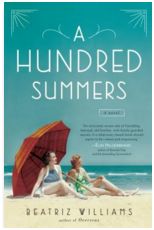Book review: A Hundred Summers
 Plot in a nutshell: Boy meets girl. Boy loses girl. Years later, boy returns into girl’s life, now married to girl’s best friend.
Plot in a nutshell: Boy meets girl. Boy loses girl. Years later, boy returns into girl’s life, now married to girl’s best friend.
Classic story, but it’s what the author does with it.
This wonderful debut novel by Beatriz Williams is told in alternating story lines. The first unrolls in 1931 as smart, ambitious Smith College senior Lily Dane accompanies her classmate and childhood friend, Budgie, to a Dartmouth football team where she meets the dashing quarterback, Nick Greenwald.
It’s (almost) love at first sight. While Lily, the daughter of a prominent New York family, is not influenced by the fact that Nick is half-Jewish, this is something frowned upon in her social caste, and not accepted by her family.
The second story line is set in the summer of 1938, at the privileged (fictional) Rhode Island seaside community of Seaview. Lily is spending the beach season with her family, and standing in as surrogate mother to her little sister Kiki while her own mother favors days spent drinking and playing bridge. After years of absence, Budgie returns to Seaview on the arm of her new husband, Nick Greenwald.
The use of these two story lines keeps the novel moving along quickly, as we follow the college love story of Lily and Nick, and the slow unraveling of the events that tore them apart and led Nick to marry Lily’s closest friend. The atmosphere of the late 1930s Connecticut beach community in the idyllic days before the storm of the century will hit the coast is evocative, and Lily’s role as the responsible adult of the family quickly becomes clear.
I enjoyed Williams’ writing style, her use of descriptive details that made me wish I’d been reading this beach side myself, and her interesting cast of characters. I’ll look forward to reading more of her novels.
The aspects that worked less for me was the consistent use of the page turner between the 1931/1938 chapters. I think this can work well once in a while, but it is clear this novel isn’t a thriller, and I didn’t feel this device was necessary. Lily’s character also disappointed me a bit. She starts off smart and ambitious, with plans for a real career (not simply a diploma to marry well), but she’s too often unrealistically naive and often left me frustrated as a reader. Likewise, Budgie could have been painted with a finer brush. Female friendships/rivalries can often be the most interesting aspect of women’s fiction, but Budgie is too much the villain to merit much interest.
Despite these minor concerns, I really enjoyed this book. I’m a sucker for most books set in the past, so I am pleased to see Beatriz Williams has others I’m certain to enjoy reading. Pull up a beach towel and enjoy this excellent read.